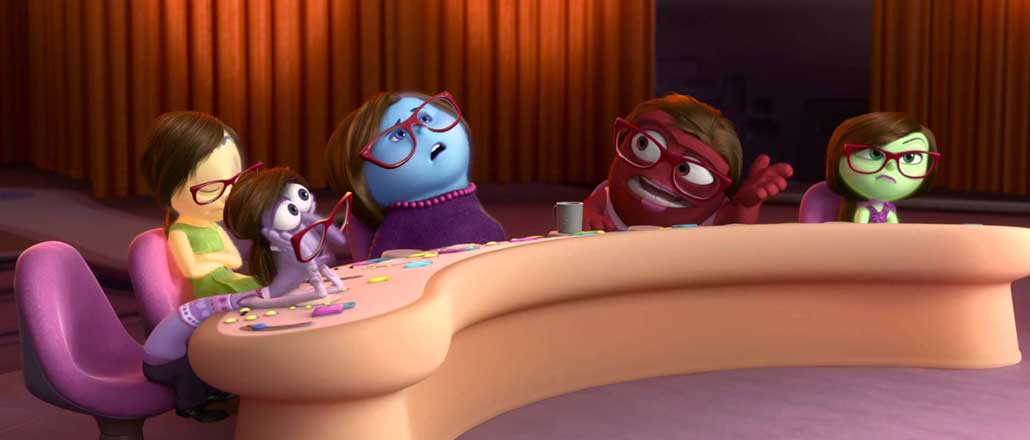[av_image src=’http://jayruud.com/wp-content/uploads/2014/12/3-12.jpg’ attachment=313′ attachment_size=’square’ align=’left’ animation=’left-to-right’ link=” target=” styling=” caption=’yes’ font_size=” appearance=’on-hover’]
Ruud Rating
INSIDE OUT
Three Tennysons/Half Shakespeare[/av_image]
Back in the fifth century, a Latin writer named Prudentius composed a poem called Psychomachia (the “Battle of the Spirits”), in which he personified virtues and vices that might coexist within the human mind and portrayed them at war with one another: Chastity is assaulted by Lust, Patience is attacked by Anger, Greed is presented as the enemy of Love. It was the first of a whole literary tradition of allegory—the personifying of abstractions—popular throughout the Middle Ages and into the Renaissance. Flip the calendar forward to 2015, and Pixar has come up with a “creative” and “new” approach to presenting internal conflicts by externalizing them (the inside does come out) and presenting them in the form of…personified abstractions.
Not that I have anything against this approach. It worked for a thousand years back in the day, why shouldn’t it work now? Especially when it is undergirded by contemporary psychology and entertainingly voiced by the likes of Amy Pohler (as the sometimes overbearing Joy), Phyllis Smith (as the overlooked but ultimately vital Sadness), Bill Hader (as Fear), Mindy Kaling (as Disgust), and the absolutely hilarious Lewis Black (as, who else, Anger).
There are two levels to the plot of “Inside Out”: there’s, well, an inside and an outside. The outside, or surface plot, goes like this: Riley (Kaitlyn Davis) is an eleven-year old girl who moves from Minneapolis to San Francisco. Hard enough for a child of any age, but for a pre-adolescent eleven-year-old girl, forced to leave all of her friends and her most avid interests (ice hockey in Riley’s case) and start over again, a real trauma. Riley’s parents (voiced by Diane Lane and Kyle MacLachlan) are having their own difficulties adjusting, and her mother expresses her gratitude to Riley for taking everything in stride in being her “happy little girl.”
But Riley is called on by her teacher on her first day at her new school and forced to introduce herself to her classmates, breaking down in the midst of her introduction as she realizes how much she has lost. Her audition for the local hockey team also goes awry, and Riley spins emotionally out of control.
The parallel inside plot follows Riley’s personified feelings—Joy, Sadness, Anger, Fear, and Disgust—as they react to the things that are occurring in the outside world, and try to drive Riley in particular directions. In this they are led primarily by Joy, who believes she must be dominant in Riley’s life, largely to the exclusion of other emotions. The inner feelings preserve Riley’s memories, most of which—particularly the “core memories” that are stored deepest in Riley’s psyche—are the color of joy.
With the family’s move to San Francisco, however, Sadness begins to take a more active role in matters inside Riley’s head, much to Joy’s dismay. Not only does Joy struggle against events as she seeks to dominate Riley’s psyche, but at the same time she does everything she can to keep Sadness down and negate any effects that contrary emotion might have in Riley’s emotional life. But when Joy and Sadness are accidentally sucked deep into Riley’s long term memory, where they meet the nearly forgotten Bing Bong, Riley’s imaginary friend (Richard Kind), who helps them as they struggle to return to the control center of Riley’s mind. In their absence, Anger, Fear and Disgust have taken over and have steered Riley onto what may be a disastrous path.
“Inside Out” has four major positives going for it: First, its allegorical presentation of the workings of the mind—the subconscious, the memory, the intertwined emotions—is creative, imaginative, and entertaining, even if it is 1500 years old. Second, the story allows for moments of clever humor (the “train of thought” is an actual train that puffs along the tracks of Riley’s mind; dreams are created in a “dream factory,” complete with a production crew and soundstage. One of Riley’s more frightening memories is a clown from an early birthday party). Third, the voices of the television personalities who inhabit the major roles do a remarkable job bringing those characters to life. Finally and most importantly, the film undercuts the dangerous attitude that all our emotions must be sublimated to happiness in favor of a healthier acceptance of sadness, anger and fear. It is a message that may surprise audiences expecting Joy to win out in the end, as a good summer Hollywood blockbuster should.
The film is animated, but may be beyond the grasp of small children. Adults will get the most out of it, but eleven-year-olds who can relate to Riley’s plight are likely to grasp most of the subtleties of Docter’s story. This is a film that ranks with Dokter’s other great triumphs—“Toy Story” and “Up”—and as such is likely to be the best animated film of the year. I’ll give this one three Tennysons and half a Shakespeare.

